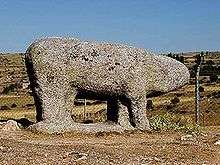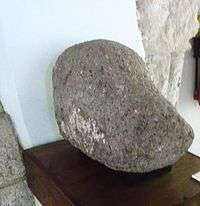Verraco


.jpg)
The verracos (Spanish: verraco; Portuguese: berrão) are granite megalithic monuments, sculptures of animals that are to be found in the west of the Iberian meseta - the high central plain of the Iberian peninsula - in the Spanish provinces of Ávila, Salamanca, Zamora, and Cáceres, but also in the north of Portugal and Galicia. Over 400 have been identified.
The Spanish word verraco normally refers to boars and the sculptures are sometimes called verracos de piedra (pigs of stone) to distinguish them from live animals. The stone verracos appear to represent not only pigs but also other animals. Some have been identified as bulls, and the village of El Oso, Ávila, named for "the Bear", has a verraco which supposedly represents a bear. Their dates range from the mid 4th to 1st centuries BC. There is some similar zoomorphic monument markers in lands of Poland from the same period or older.
Though they were perhaps not confined to a single usage, the verracos were an essential part of the landscape of the Vettones, one of the Pre-Roman peoples of the Iberian Peninsula. It has generally been assumed from their high visibility in their original open fields surroundings that these sculptures had some protective religious significance, whether guarding the security of livestock or as funerary monuments (some of them bear Latin funerary inscriptions). The verracos are particularly numerous too in the vicinity of the walled Celtiberian communities that Romans called oppida.
Notable verracos
Portugal
- Murça
- Torre de Dona Chama
- Berroa
- Marvão
- Head of berrão, with right eye clearly visible, found in the Abegoa area of Marvão. Today in Municipal Museum in Marvão.
 Verraco head (Portuguese: berrão) displayed in the Marvão Municipal Museum
Verraco head (Portuguese: berrão) displayed in the Marvão Municipal Museum
-
Spain
- El Tiemblo, Ávila (province)
- Bulls of Guisando, 4 verracos mentioned by Cervantes. They are protected as a sitio histórico or cultural landscape.
- Salamanca
- One verraco next to the Roman bridge. It is mentioned in the sixteenth-century picaresque novel Lazarillo de Tormes as being like a bull:[2]
Salimos de Salamanca y, llegando a la puente, está a la entrada de ella un animal de piedra que
casi tiene forma de toro. El ciego me mandó que llegase cerca del animal y, allí puesto, me
dijo...
- Villanueva del Campillo, Ávila (province)
- Two verracos, one of which is possibly the largest of them all (a larger than life-size bull or aurochs, but surviving in an incomplete state).
Further reading
- J. Leite de Vasconcelos, Religiões da Lusitânia, Imprensa Nacional Casa da Moeda, Lisbon.
- Eduardo Sánchez Moreno, 2000. Vetones: Historia y Arqueología de un pueblo prerromano (Madrid: Ediciones de la Universidad Autónoma)
External links
- Jesús R. Álvarez-Sanchís, "Oppida and Celtic society in western Spain," in e-Celtoi: Journal of Interdisciplinary Celtic Studies vol 6 (The Celts in the Iberian Peninsula)
- Photo gallery of verracos